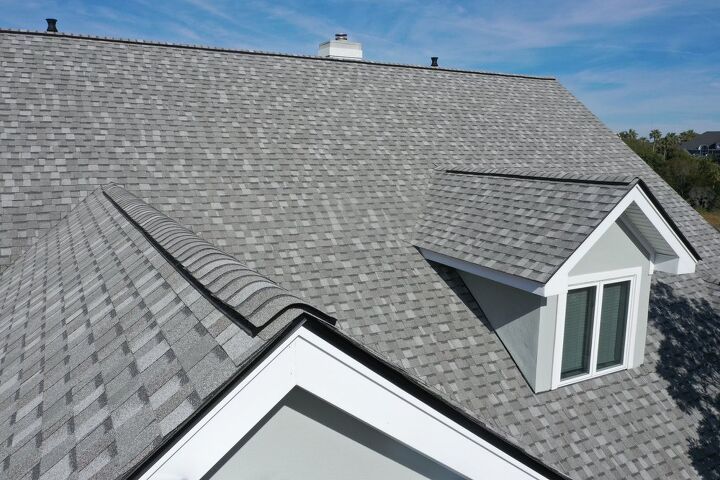Will A New Roof Make My House Warmer?

The roof is one of the most important parts of your home because it protects you from all of the elements and provides insulation. However, if your roof is old or in poor shape, then it could be making your house unbearably cold during the winter months.
Will a new roof make your house warmer?
A new roof will make your house warmer if cool air seeps in due to damage to the roof itself. New roofing will also provide yearly energy cost savings, better ventilation, and more solar reflection. If you want to lock heat in, opt for a clay tile or concrete material roof.
If you are considering replacing your roof, get a quote from local contractors in your area here.
Does an Old Roof Allow Cold Air Inside?
Older roofs can cause all sorts of problems, one of which is letting cold air into your home.
If the roofing material on a house is worn, it can allow the elements to seep in from the outside. This occurs because roofs get brittle from wind and sun damage over time. Additionally, wood shingles wear down, allowing for gaps that let heat escape.
Should you live in an area where temperatures commonly dip below zero and icicles form on the perimeter of your house, your roof will also suffer. Overall, these factors will shorten the lifespan of your roof and put extra pressure on your heating and cooling system to pick up the slack.
What should you do about this?
Will a New Roof Make My House Warmer?
If you’ve noticed a draft upstairs that’s not coming from open windows, then your roof may be letting cold air inside. If you reside in a state where harsh winters are common, it might be time to upgrade to a newer model.
Replacing your roof will fix any exterior space that allows outside air into your home.
Here’s what you can expect with a new roof:
- An increase in the energy efficiency of your home
- Protection for your belongings inside from extreme weather
- Prevention of structural damage to wooden parts of the home, such as the basement and attic
- Savings of 10% or greater on heating costs during winter months
- Better ventilation and more solar reflection
If you want to keep more money in your pocket this year but aren’t sure if you should patch or replace your roof, consider this:
Most roofing materials are built to last about 30 years before they need replacing. If an old roof hasn’t reached its lifespan yet, then it might make sense to try fixing normal wear and tear first rather than spending hundreds or potentially thousands on a replacement.
Otherwise, have a professional assess the structural integrity of your roof and determine if it’s time to bite the bullet and put a new one on.
Which material locks in heat the best?
Choosing a roofing material that locks in heat is important when it comes to keeping your house warmer.
Here’s how some popular materials compare:
- Concrete and clay tile roofs are the best at locking in heat. They’re durable and air-tight.
- Aluminum and other metal roofs are wind resistant and can be tightly sealed when installed properly.
- Solar shingles are a good option if you want to generate some of your own electricity.
- Wood shingles are aesthetically interesting but allow for greater airflow, so they aren’t ideal if you’re trying to keep heat in.
- Cedar shakes are more energy-efficient than some materials, but they’re susceptible to rot.
- Asphalt shingles are a good middle ground, but choose a color that’s going to attract sunlight.
The best type of roofing material for you depends on your needs and the climate you live in.
By replacing your roof with one of these materials that lock in heat, you’ll enjoy warmer rooms during winter months. It will also give your house extra insulation overall, which makes savings on heating costs during the colder months possible!
Furthermore, we all know that dark-colored cars attract heat. The same principle applies to a roof. So, if your roof is a darker shade, it will attract more sunlight (even when it’s cold outside) and retain heat better.
Should You Replace Your Roof in the Winter?
Whether or not you should replace your roof in the winter depends on where you live.
If your colder months are brutal, replacing your roof in the winter might create some project timeline delays. Some workers may not want to work outside in the elements when it’s sub-zero, so you will have fewer options as far as hiring a reliable company.
That being said, roofers are much less busy in the wintertime. So if they agree to the job, you’ll likely have a new roof quicker than expected (given you don’t experience any weather delays).
Replacing your roof in the winter if you live in a place like Florida should be no problem!
In either situation, you’ll still be able to live in your house while the work is done. Your family will just have to tolerate some banging around for a week.
Note: Asphalt shingles will have to be hand-sealed if the temperature is below 40° F.
Related Questions
Does putting a new roof on your house add value?
Adding a new roof to your home definitely adds value, but you should keep in mind that it will come out of your wallet first.A new roof adds about $12,000 more to your home, so weigh the pros and cons regarding if it’s worth it to take on a project this large before you sell.
Will a new roof lower my homeowner’s insurance premium?
New roofing will usually lower your homeowner’s insurance premium because it makes your home safer and less susceptible to major damage. Many companies offer discounts after this is completed.
Is a roof leak covered by insurance?
Most policies typically cover roof leaks, but it’s best to check with your insurance company first.
In Summary
A new roof will most definitely make your house warmer in the winter.
If you’re not sure which roofing material to choose, it’s best to consult with a professional home inspector or contractor. They will be able to provide valuable insight on which type of materials are best for your situation and climate.
UpgradedHome participates in affiliate programs. When you purchase through our links, we may earn a commission.

Emily is a copywriter with over five years of experience in crafting content for the home renovation and remodeling industry. She loves house projects, whether it be painting a room or tweaking small design elements to transform a space. Her favorite aesthetic is french modern because of its clean lines and airy feeling! When not writing, Emily loves to travel and check out architectural details all over the world.
More by Emily Carr



























